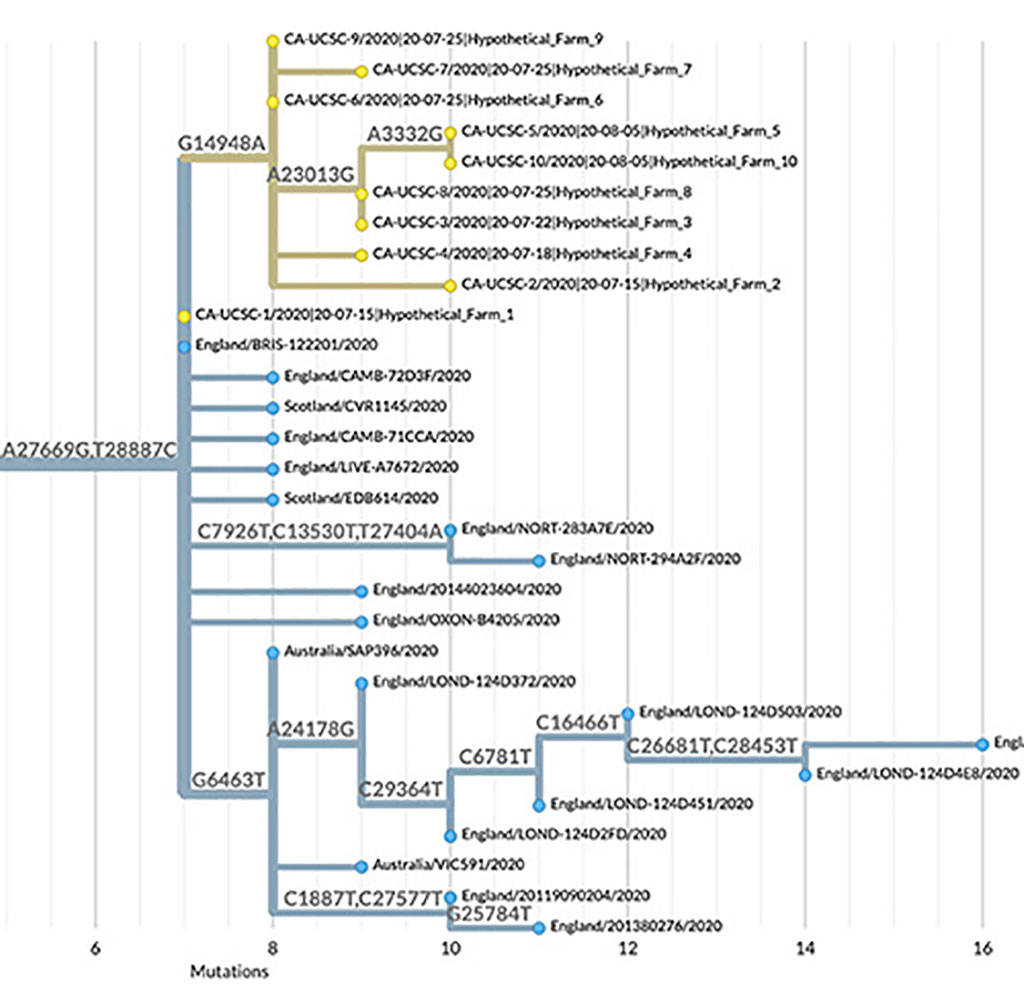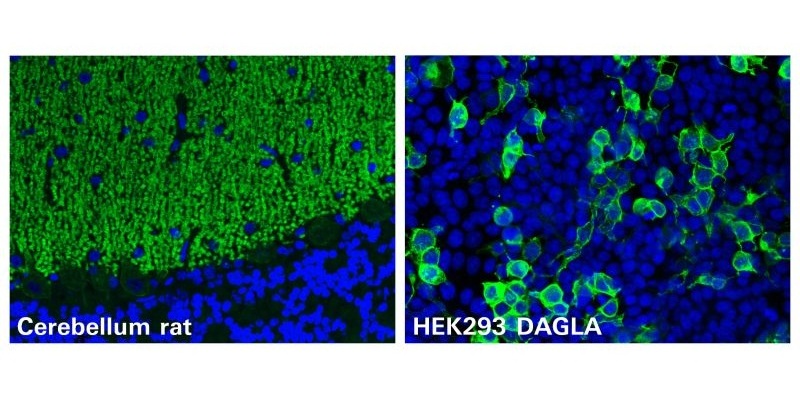New Tools Enable Rapid Analysis of Coronavirus Sequences and Tracking of SARS-CoV-2 Variants
|
By LabMedica International staff writers Posted on 11 May 2021 |

Image: In this example of UShER results, displayed using Nextstrain, sequences representing a hypothetical outbreak are yellow, previously sampled sequences are blue, and branches are labeled by nucleotide mutations (Photo courtesy of UCSC Genomics Institute)
A new tool allows researchers to quickly see how a new viral sequence is related to all other variants of SARS-CoV-2, crucial information for tracking transmission dynamics.
The sheer number of coronavirus genome sequences and their rapid accumulation makes it hard to place new sequences on a “family tree” showing how they are all related. But researchers at the UC Santa Cruz Genomics Institute (Santa Cruz, CA, USA) have developed a new method that does this with unprecedented speed. Called Ultrafast Sample Placement on Existing Trees (UShER), this powerful tool identifies the relationships between a user’s newly sequenced viral genomes and all known SARS-CoV-2 virus genomes by adding them to an existing phylogenetic tree, a branching diagram like a family tree that shows how the virus has evolved in different lineages as it accumulates mutations.
This kind of sequence analysis can be used to discover new strains of the virus as they emerge and track their evolution and transmission dynamics. It can also be used to identify links between individual cases of coronavirus infection and to trace chains of transmission, an approach known as genomic contact tracing. UShER and related data visualization tools are available to the research community through the UCSC SARS-CoV-2 Genome Browser, which also provides access to a wide range of data and results from ongoing scientific research on the virus, including new variants that are especially concerning.
Like all viruses, SARS-CoV-2 acquires mutations as it replicates and spreads. Most of these random variations in the genome sequence have no effect on the behavior of the virus, but researchers can still use them to identify different variants or strains of the virus, see how they are related, and determine if two samples are part of the same transmission chain. Viral genomics can reveal transmission chains not found through conventional contact tracing. This approach can help identify superspreader events, where one person transmitted the virus to many others, and it can also show that two cases from the same location are actually unrelated infections, not part of the same transmission chain, because the viral sequences differ too much.
“We are able to maintain a comprehensive phylogenetic tree of more than 1.2 million coronavirus sequences and update it with new sequences in real time. No other tool can handle trees of this size with a comparable efficiency,” said first author Yatish Turakhia, a postdoctoral scholar at the Genomics Institute. “This helps us keep track of all variants in circulation, including new variants that are emerging.”
“It’s an approach that is likely to be valuable moving forward, so we’re building the tools to enable people to do this in real time,” said Russ Corbett-Detig, assistant professor of biomolecular engineering at UC Santa Cruz. “If you want to know who transmitted the virus to whom, or where in the world a new sample may have come from, you need to take the samples from your community and project them onto the known phylogenetic tree of all the other SARS-CoV-2 genome sequences, and conventional phylogenetic methods just can’t do this in a reasonable amount of time.”
Related Links:
UC Santa Cruz Genomics Institute
The sheer number of coronavirus genome sequences and their rapid accumulation makes it hard to place new sequences on a “family tree” showing how they are all related. But researchers at the UC Santa Cruz Genomics Institute (Santa Cruz, CA, USA) have developed a new method that does this with unprecedented speed. Called Ultrafast Sample Placement on Existing Trees (UShER), this powerful tool identifies the relationships between a user’s newly sequenced viral genomes and all known SARS-CoV-2 virus genomes by adding them to an existing phylogenetic tree, a branching diagram like a family tree that shows how the virus has evolved in different lineages as it accumulates mutations.
This kind of sequence analysis can be used to discover new strains of the virus as they emerge and track their evolution and transmission dynamics. It can also be used to identify links between individual cases of coronavirus infection and to trace chains of transmission, an approach known as genomic contact tracing. UShER and related data visualization tools are available to the research community through the UCSC SARS-CoV-2 Genome Browser, which also provides access to a wide range of data and results from ongoing scientific research on the virus, including new variants that are especially concerning.
Like all viruses, SARS-CoV-2 acquires mutations as it replicates and spreads. Most of these random variations in the genome sequence have no effect on the behavior of the virus, but researchers can still use them to identify different variants or strains of the virus, see how they are related, and determine if two samples are part of the same transmission chain. Viral genomics can reveal transmission chains not found through conventional contact tracing. This approach can help identify superspreader events, where one person transmitted the virus to many others, and it can also show that two cases from the same location are actually unrelated infections, not part of the same transmission chain, because the viral sequences differ too much.
“We are able to maintain a comprehensive phylogenetic tree of more than 1.2 million coronavirus sequences and update it with new sequences in real time. No other tool can handle trees of this size with a comparable efficiency,” said first author Yatish Turakhia, a postdoctoral scholar at the Genomics Institute. “This helps us keep track of all variants in circulation, including new variants that are emerging.”
“It’s an approach that is likely to be valuable moving forward, so we’re building the tools to enable people to do this in real time,” said Russ Corbett-Detig, assistant professor of biomolecular engineering at UC Santa Cruz. “If you want to know who transmitted the virus to whom, or where in the world a new sample may have come from, you need to take the samples from your community and project them onto the known phylogenetic tree of all the other SARS-CoV-2 genome sequences, and conventional phylogenetic methods just can’t do this in a reasonable amount of time.”
Related Links:
UC Santa Cruz Genomics Institute
Latest COVID-19 News
- New Immunosensor Paves Way to Rapid POC Testing for COVID-19 and Emerging Infectious Diseases
- Long COVID Etiologies Found in Acute Infection Blood Samples
- Novel Device Detects COVID-19 Antibodies in Five Minutes
- CRISPR-Powered COVID-19 Test Detects SARS-CoV-2 in 30 Minutes Using Gene Scissors
- Gut Microbiome Dysbiosis Linked to COVID-19
- Novel SARS CoV-2 Rapid Antigen Test Validated for Diagnostic Accuracy
- New COVID + Flu + R.S.V. Test to Help Prepare for `Tripledemic`
- AI Takes Guesswork Out Of Lateral Flow Testing
- Fastest Ever SARS-CoV-2 Antigen Test Designed for Non-Invasive COVID-19 Testing in Any Setting
- Rapid Antigen Tests Detect Omicron, Delta SARS-CoV-2 Variants
- Health Care Professionals Showed Increased Interest in POC Technologies During Pandemic, Finds Study
- Set Up Reserve Lab Capacity Now for Faster Response to Next Pandemic, Say Researchers
- Blood Test Performed During Initial Infection Predicts Long COVID Risk
- Low-Cost COVID-19 Testing Platform Combines Sensitivity of PCR and Speed of Antigen Tests
- Finger-Prick Blood Test Identifies Immunity to COVID-19
- Quick Test Kit Determines Immunity Against COVID-19 and Its Variants
Channels
Clinical Chemistry
view channel
‘Brilliantly Luminous’ Nanoscale Chemical Tool to Improve Disease Detection
Thousands of commercially available glowing molecules known as fluorophores are commonly used in medical imaging, disease detection, biomarker tagging, and chemical analysis. They are also integral in... Read more
Low-Cost Portable Screening Test to Transform Kidney Disease Detection
Millions of individuals suffer from kidney disease, which often remains undiagnosed until it has reached a critical stage. This silent epidemic not only diminishes the quality of life for those affected... Read more
New Method Uses Pulsed Infrared Light to Find Cancer's 'Fingerprints' In Blood Plasma
Cancer diagnoses have traditionally relied on invasive or time-consuming procedures like tissue biopsies. Now, new research published in ACS Central Science introduces a method that utilizes pulsed infrared... Read moreMolecular Diagnostics
view channel
Blood Biomarker Test Could Detect Genetic Predisposition to Alzheimer’s
New medications for Alzheimer’s disease, the most common form of dementia, are now becoming available. These treatments, known as “amyloid antibodies,” work by promoting the removal of small deposits from... Read more
Novel Autoantibody Against DAGLA Discovered in Cerebellitis
Autoimmune cerebellar ataxias are strongly disabling disorders characterized by an impaired ability to coordinate muscle movement. Cerebellar autoantibodies serve as useful biomarkers to support rapid... Read more
Gene-Based Blood Test Accurately Predicts Tumor Recurrence of Advanced Skin Cancer
Melanoma, an aggressive form of skin cancer, becomes extremely difficult to treat once it spreads to other parts of the body. For patients with metastatic melanoma tumors that cannot be surgically removed... Read moreHematology
view channel
New Scoring System Predicts Risk of Developing Cancer from Common Blood Disorder
Clonal cytopenia of undetermined significance (CCUS) is a blood disorder commonly found in older adults, characterized by mutations in blood cells and a low blood count, but without any obvious cause or... Read more
Non-Invasive Prenatal Test for Fetal RhD Status Demonstrates 100% Accuracy
In the United States, approximately 15% of pregnant individuals are RhD-negative. However, in about 40% of these cases, the fetus is also RhD-negative, making the administration of RhoGAM unnecessary.... Read moreImmunology
view channel
Stem Cell Test Predicts Treatment Outcome for Patients with Platinum-Resistant Ovarian Cancer
Epithelial ovarian cancer frequently responds to chemotherapy initially, but eventually, the tumor develops resistance to the therapy, leading to regrowth. This resistance is partially due to the activation... Read more
Machine Learning-Enabled Blood Test Predicts Immunotherapy Response in Lymphoma Patients
Chimeric antigen receptor (CAR) T-cell therapy has emerged as one of the most promising recent developments in the treatment of blood cancers. However, over half of non-Hodgkin lymphoma (NHL) patients... Read moreMicrobiology
view channel
Handheld Device Delivers Low-Cost TB Results in Less Than One Hour
Tuberculosis (TB) remains the deadliest infectious disease globally, affecting an estimated 10 million people annually. In 2021, about 4.2 million TB cases went undiagnosed or unreported, mainly due to... Read more
New AI-Based Method Improves Diagnosis of Drug-Resistant Infections
Drug-resistant infections, particularly those caused by deadly bacteria like tuberculosis and staphylococcus, are rapidly emerging as a global health emergency. These infections are more difficult to treat,... Read more
Breakthrough Diagnostic Technology Identifies Bacterial Infections with Almost 100% Accuracy within Three Hours
Rapid and precise identification of pathogenic microbes in patient samples is essential for the effective treatment of acute infectious diseases, such as sepsis. The fluorescence in situ hybridization... Read morePathology
view channel
Novel UV and Machine Learning-Aided Method Detects Microbial Contamination in Cell Cultures
Cell therapy holds great potential in treating diseases such as cancers, inflammatory conditions, and chronic degenerative disorders by manipulating or replacing cells to restore function or combat disease.... Read more
New Error-Corrected Method to Help Detect Cancer from Blood Samples Alone
"Liquid biopsy" technology, which relies on blood tests for early cancer detection and monitoring cancer burden in patients, has the potential to transform cancer care. However, detecting the mutational... Read more
"Metal Detector" Algorithm Hunts Down Vulnerable Tumors
Scientists have developed an algorithm capable of functioning as a "metal detector" to identify vulnerable tumors, marking a significant advancement in personalized cancer treatment. This breakthrough... Read more
Novel Technique Uses ‘Sugar’ Signatures to Identify and Classify Pancreatic Cancer Cell Subtypes
Pancreatic cancer is often asymptomatic in its early stages, making it difficult to detect until it has progressed. Consequently, only 15% of pancreatic cancers are diagnosed early enough to allow for... Read moreTechnology
view channel
Disposable Microchip Technology Could Selectively Detect HIV in Whole Blood Samples
As of the end of 2023, approximately 40 million people globally were living with HIV, and around 630,000 individuals died from AIDS-related illnesses that same year. Despite a substantial decline in deaths... Read more
Pain-On-A-Chip Microfluidic Device Determines Types of Chronic Pain from Blood Samples
Chronic pain is a widespread condition that remains difficult to manage, and existing clinical methods for its treatment rely largely on self-reporting, which can be subjective and especially problematic... Read more
Innovative, Label-Free Ratiometric Fluorosensor Enables More Sensitive Viral RNA Detection
Viruses present a major global health risk, as demonstrated by recent pandemics, making early detection and identification essential for preventing new outbreaks. While traditional detection methods are... Read moreIndustry
view channel
Cepheid and Oxford Nanopore Technologies Partner on Advancing Automated Sequencing-Based Solutions
Cepheid (Sunnyvale, CA, USA), a leading molecular diagnostics company, and Oxford Nanopore Technologies (Oxford, UK), the company behind a new generation of sequencing-based molecular analysis technologies,... Read more
Grifols and Tecan’s IBL Collaborate on Advanced Biomarker Panels
Grifols (Barcelona, Spain), one of the world’s leading producers of plasma-derived medicines and innovative diagnostic solutions, is expanding its offer in clinical diagnostics through a strategic partnership... Read more





















